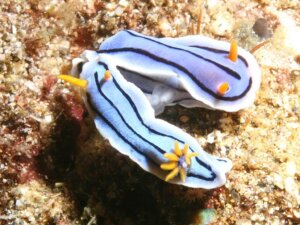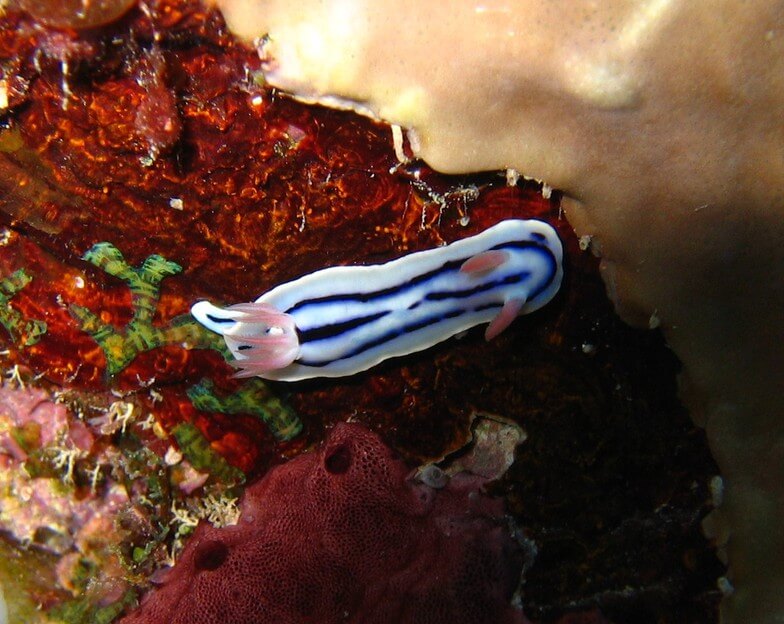Learn all About the Chromodoris Lochi, a Very Strange Mollusk


Written and verified by the biologist Cesar Paul Gonzalez Gonzalez
Mollusks are one of the most diverse groups in the world, as there are so many different shapes, colors, and sizes. This is especially the case at the bottom of the sea, where there are still several undiscovered specimens. Among the most curious is the Chromodoris lochi.
The Chromodoris lochi belongs to a special group of mollusks known as nudibranchs. These creatures are characterized by not having shells and exposing their gills to the environment. Read on to find out more about this species.
Habitat and distribution
This mollusk is found in several parts of the Indo-Pacific Ocean, ranging from Malaysia, Indonesia, and the Philippines to the northern coasts of Australia. Due to its feeding habits, specimens are found associated with coral reefs, with a depth of between 5 and 30 meters.

Physical characteristics
The general appearance of Chromodoris lochi is quite similar to that of a terrestrial slug, with the big difference that it’s more colorful. In fact, this is the reason why nudibranchs are also known as sea slugs. On average, they measure about 4 centimeters (just under 2 inches) in length.
The body of this species maintains an oval shape with pale blue colors, in addition to several black lines that run through the center and edges of the species. To find their way around, they use two orange tentacles located on their head, which serve as antennae. Likewise, they have two tentacles near their mouth that are used to sniff their environment.
Although they don’t have eyes, the Chromodoris lochi has a small sphere on its head that they use to perceive shadows. In addition, it’s possible to observe a type of appendage on its back similar to “feathers”, but they’re are actually gills. These structures are the ones that obtain oxygen from the water and help it to breathe.
Behavior
Usually, the life of this small mollusk is quite calm, and it doesn’t move very fast. However, thanks to their elongated and flat shape, they’re able to use their bodies to swim and move easily on the ocean floor.
Food
Despite its appearance, the Chromodoris lochi is a carnivorous organism that feeds on other invertebrates such as sponges. Although it’s true that this nudibranch doesn’t have a jaw, it has a structure known as a radula that helps it to crush its food.
An interesting aspect of this and other nudibranchs is that they’re capable of assimilating certain toxins from their prey. Specifically, they accumulate these molecules and relocate them in certain glands on their skin, with which they coat their body to protect themselves from predators.
In fact, this is why the species is so brightly colored, as it serves as a warning to its aggressors (aposematism).
Reproduction
Although much information about the natural history of this species is unknown, it is believed that its reproduction follows the same pattern as that of other nudibranchs. This means that specimens are hermaphrodites, but they need a mate in order to procreate.

Moreover, there’s a small struggle to see who plays the role of male and who plays the role of female. During this battle, both try to penetrate the other with a pointed structure. The successful specimen is the dominant male, while the loser must act as the female and produce the respective eggs.
As you can see, the Chromodoris lochi is an intriguing species that lives in the beautiful coral reefs. While it’s true that these places are characterized by several colorful animals, nudibranchs are one of the most curious groups that can be observed.
Mollusks are one of the most diverse groups in the world, as there are so many different shapes, colors, and sizes. This is especially the case at the bottom of the sea, where there are still several undiscovered specimens. Among the most curious is the Chromodoris lochi.
The Chromodoris lochi belongs to a special group of mollusks known as nudibranchs. These creatures are characterized by not having shells and exposing their gills to the environment. Read on to find out more about this species.
Habitat and distribution
This mollusk is found in several parts of the Indo-Pacific Ocean, ranging from Malaysia, Indonesia, and the Philippines to the northern coasts of Australia. Due to its feeding habits, specimens are found associated with coral reefs, with a depth of between 5 and 30 meters.

Physical characteristics
The general appearance of Chromodoris lochi is quite similar to that of a terrestrial slug, with the big difference that it’s more colorful. In fact, this is the reason why nudibranchs are also known as sea slugs. On average, they measure about 4 centimeters (just under 2 inches) in length.
The body of this species maintains an oval shape with pale blue colors, in addition to several black lines that run through the center and edges of the species. To find their way around, they use two orange tentacles located on their head, which serve as antennae. Likewise, they have two tentacles near their mouth that are used to sniff their environment.
Although they don’t have eyes, the Chromodoris lochi has a small sphere on its head that they use to perceive shadows. In addition, it’s possible to observe a type of appendage on its back similar to “feathers”, but they’re are actually gills. These structures are the ones that obtain oxygen from the water and help it to breathe.
Behavior
Usually, the life of this small mollusk is quite calm, and it doesn’t move very fast. However, thanks to their elongated and flat shape, they’re able to use their bodies to swim and move easily on the ocean floor.
Food
Despite its appearance, the Chromodoris lochi is a carnivorous organism that feeds on other invertebrates such as sponges. Although it’s true that this nudibranch doesn’t have a jaw, it has a structure known as a radula that helps it to crush its food.
An interesting aspect of this and other nudibranchs is that they’re capable of assimilating certain toxins from their prey. Specifically, they accumulate these molecules and relocate them in certain glands on their skin, with which they coat their body to protect themselves from predators.
In fact, this is why the species is so brightly colored, as it serves as a warning to its aggressors (aposematism).
Reproduction
Although much information about the natural history of this species is unknown, it is believed that its reproduction follows the same pattern as that of other nudibranchs. This means that specimens are hermaphrodites, but they need a mate in order to procreate.

Moreover, there’s a small struggle to see who plays the role of male and who plays the role of female. During this battle, both try to penetrate the other with a pointed structure. The successful specimen is the dominant male, while the loser must act as the female and produce the respective eggs.
As you can see, the Chromodoris lochi is an intriguing species that lives in the beautiful coral reefs. While it’s true that these places are characterized by several colorful animals, nudibranchs are one of the most curious groups that can be observed.
All cited sources were thoroughly reviewed by our team to ensure their quality, reliability, currency, and validity. The bibliography of this article was considered reliable and of academic or scientific accuracy.
- Avila, C. (1993). Sustancias naturales de moluscos opistobranquios: estudio de su estructura, origen y función en ecosistemas bentónicos (Doctoral dissertation, Universitat de Barcelona).
- Prinsep, M. R. (2003). Sulfur-containing natural products from marine invertebrates. Studies in Natural Products Chemistry, 28, 617-751.
- Trickey, J. S., Vanner, J., & Wilson, N. G. (2013). Reproductive variance in planar spawning Chromodoris species (Mollusca: Nudibranchia). Molluscan research, 33(4), 265-271.
- Tibiriçá, Y., Pola, M., Ortigosa, D., & Cervera, J. L. (2020). Systematic review of the “Chromodoris quadricolor group” of East Africa, with descriptions of two new species of the genus Chromodoris Alder & Hancock, 1855 (Heterobranchia, Nudibranchia). Journal of Zoological Systematics and Evolutionary Research, 58(1), 230-261.
- Hubner, G. (2011). Nudibranch neighborhood: the distribution of two nudibranch species (Chromodoris lochi and Chromodoris sp.) in Cook’s bay, Mo’orea, French Polynesia. Anthropology, University of California, Berkeley.
This text is provided for informational purposes only and does not replace consultation with a professional. If in doubt, consult your specialist.








